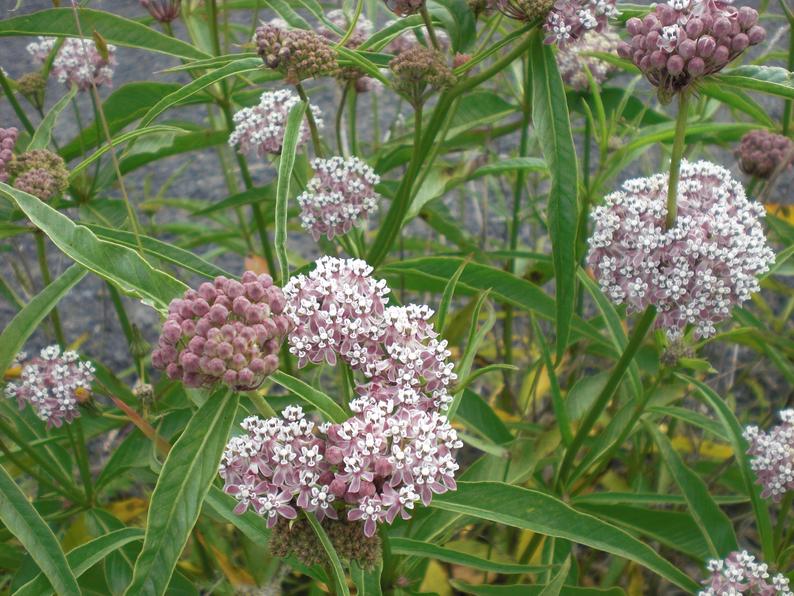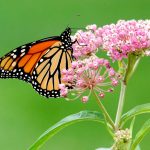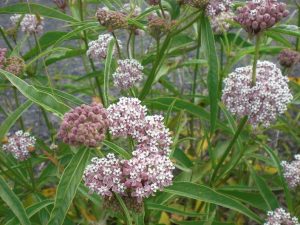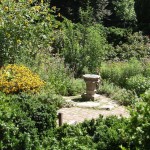
Which milkweed should I plant in Southern California?
 I’ve caught the milkweed bug. It all started with an accidental visit to a City of Santa Monica building near Santa Monica airport. They had planted milkweed outside the building, 18+ plants by my count, and there were TONS of monarch larvae, with lines of chrysalises along the building’s siding. A few adult monarchs fluttered about, checking the place out. I wanted a milkweed patch at my place!
I’ve caught the milkweed bug. It all started with an accidental visit to a City of Santa Monica building near Santa Monica airport. They had planted milkweed outside the building, 18+ plants by my count, and there were TONS of monarch larvae, with lines of chrysalises along the building’s siding. A few adult monarchs fluttered about, checking the place out. I wanted a milkweed patch at my place!
I’d heard some controversy about milkweeds, that we shouldn’t be planting Tropical Milkweed, but I wasn’t sure.
The catch was, what kind of milkweed should I plant?
How can I help the monarchs?
“Planting milkweed” seemed to be an obvious solution. But then things got a bit more complex. Which kind of milkweed? What about all that controversy over the tropical kind? What else did I need to know?
How do you tell what kind of milkweed you have?
From my review of California Native plant websites and Xerces Society information sheets, I’ve come up with an extremely simple formula. For our area:
pink & white flowers = GOOD
yellow & orange flowers = bad
The Tropical Milkweed is the one you’ll usually see at Armstrong and other chain nurseries. It has yellow/orange flowers. DON’T plant that one in Southern California.
Tropical Milkweed acts as a perennial in our area, it doesn’t go dormant. This, in turn, encourages the monarchs to not migrate, to stay here in the wrong seasons, and it can lead to a buildup of the Ophryocystis elektroscirrha infection which is detrimental to the monarchs — the complete opposite of what we are trying to do!
NO, DON’T PLANT THESE IN SOUTHERN CALIFORNIA…
- Asclepias curassavica – DO NOT PLANT. This tropical milkweed has red-orange flowers with a yellow center, and glossy-green leaves. Per the Xerces Society, its furthest northern range is in Mexico. We shouldn’t plant it in Southern California.
- Asclepias tuberosa – Jury is still out, I’m still researching this one. This milkweed has bright orange flowers, and seems to be native to other parts of the US. It is being cultivated and hybridized by the nursery industry. The problem is, often when plants are hybridized, it decreases their nectar-yielding abilities. I don’t know if this is happening with A. tuberosa. Much better, I think, to grow the California natives here.
- Asclepias speciosa – This California native has beautiful pinkish flowers. However its natural range is in Central and Northern California. We shouldn’t plant it in Southern California.
There are several California native milkweeds, which are the ones we should be planting. All of these seem to have pink, pinkish, or white flowers. For Los Angeles and Southern California, consider the following.
YES, PLANT THESE IN SOUTHERN CALIFORNIA…
- Asclepias californica – deep pinkish/magenta-ish flowers
- Asclepias eriocarpa – creamy-white flowers and broad leaves. aka Woolypod milkweed, Indian milkweed.
- Asclepias fascicularis – white flowers and narrow leaves. aka Narrow-leaved milkweed. This one should be the go-to for L.A. gardeners.
- Asclepias vestita – creamy flowers and broad leaves. aka Wooly milkweed. According to the Xerces Society, L.A. is at the southern tip of the range for this plant. If your garden is north of L.A., this one’s for you. If you live in Orange County, Riverside, San Diego, etc. I suggest you choose one of the others.
- Asclepias sublata – aka Rush milkweed. Not for L.A., but if you’re in San Diego, try planting this one. CalFlora shows its native range as the southeastern portion of California.
Remember that monarchs are more likely to be attracted to your milkweed patch if you plant a clump of several milkweed plants together in a grouping, rather than a single milkweed plant.

Don’t forget Nectar plants
People focus on milkweed because it is the larval food plant — the plant where the monarchs lay their eggs, the plant the baby caterpillars eat as they grow and prepare to go into their chrysalis.
But the adult monarchs need nectar plants. Ideas for your Southern California gardens include California native asters, California native lobelias, Cleome, ceanothus, manzanita, baccharis, and black sage. — See additional resource at bottom of this post.
What can I do for Monarchs if I live in an apartment?
You really can help!
It takes time and effort to grow milkweed from seeds. And raising seedlings is something you can do inside an apartment!
You could get some seeds of California native milkweeds, grow them into transplant size, and gift them to friends who have garden space, or gift them to schools and community gardens. (Here are some tips on starting milkweed seeds and more instructions )
That way you are helping to increase the number of milkweeds in Southern California and getting the right kind of plants out there to welcome the butterflies.
You could also grow some milkweed plants in large containers. My friend in Santa Monica grows lovely native milkweed plants in containers that are perhaps 24″ diameter x 24″ high. Watch for seed development, and save their seeds. Give the seeds to friends, guerrilla garden them, or package them up and drop them in Little Free Libraries around your local area!
Where do you get the right milkweed?
International Garden Center in El Segundo carries A. fascicularis in 4″ pots and/or one gallon pots. (at least they had it in July 2022) In July 2022, they also had A. speciosa which is for Northern California, as well as the evil tropical kind, so be careful what you buy — avoid those tell-tale yellow/orange flowers! If you plant the native varieties in late summer (which is when nurseries seem to stock it), when the weather grows cold you can expect it to die back into its rootstock, the way your bulbing flowers like narcissus would. Place a marker where its roots are (give those roots occasional water if we have a dry winter), and leave it undisturbed until spring warms up – you should see resprout at that time.
Armstrong Garden center (at least my local one in Westchester/LA 90045) carries carries A. fascicularis in 4″ pots (at least they had it in July 2022). Like International Garden Center, Armstrong also offers the inappropriate tropical, so look out for what you are purchasing.
Larner Seeds carries all kinds of California native seeds, and their supply can vary season-by-season. As I update this, in July 2022, they stock A. eriocarpa and A. fascicularis which are appropriate for our L.A. area. (They also stock A. speciosa, which is for Northern California, not for here)
If you know the botanic name and the appearance of the variety of milkweed you are seeking, you might be able to find it on other sites, such as Etsy.
When to plant milkweed
When do you plant those seeds? According to Theodore Payne Foundation, wait until the weather warms up in March — here are their instructions.
- Connolly, Kelly, Growing milkweed from seed, Theodore Payne Foundation, 2019 https://theodorepayne.org/growing-milkweed-from-seed/
Growing native milkweed
A few years into this enthusiastic journey and I’m learning: it’s insanely easy to grow the tropical milkweed that Xerces Society says we shouldn’t be planting. Growing native milkweeds … not so easy. They seem to be finicky plants.
A gardener in Thousand Oaks tells me “it grows everywhere.” First, I clarified that she was talking about the native varieties. She was. When I asked her what kind of care, she said “I don’t do anything, it sprouts on its own.” What that tells me is that typical garden care is too much for the native varieties, we need to give them a little wildness, and probably less water than you’d think they need?
As I said above, a friend in Santa Monica grows lovely native milkweed plants in containers that are perhaps 24″ diameter x 24″ high. Her pot are located in an exposed area with lots of intense sun, and she uses drip irrigation.
Read more
… [a note about downloads: they are FREE to you. Because GoogleDrive changed its permissions & sharing, I’ve had to post these on a private site. Not smooth hosting, I know. Please be patient. — JP]
A guide to common milkweeds of California, Xerces Society, 2012 (pdf) includes color photos of the above-mentioned plants
Monarch nectar plants – California Coast, Xerces Society, 2016 (pdf)
some tips on starting milkweed seeds, MonarchWatch.org (n.d.), webpage includes good descriptions of stratification, heat shocking, and scarification
Post updated July 20, 2022.
If you enjoyed this post, please consider making a small donation to support my ongoing work. — thanks!



One Comment
Pingback: